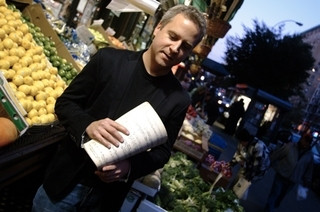|
Back
With Thanks for a Beautiful Denk Schön New York
Avery Fisher Hall, Lincoln Center
07/31/2015 - August 1, 2015
Johann Sebastian Bach/Johannes Brahms: Chaconne for piano, left hand
Wolfgang Amadeus Mozart: Piano Concerto No. 20 in D Minor, K. 466
Johannes Brahms: Symphony No. 4 in E minor, opus 98
Jeremy Denk (Pianist)
Mostly Mozart Festival Orchestra, Louis Langrée (Conductor)

J. Denk (© Denniz Calahan)
The words “unexpected” and “astonishing” go together as easily as the words “Jeremy” and “Denk”. Mr. Denk’s concerts and recitals are neither idiosyncratic nor showy, but they offer surprises of choices, of relationships, of subversive ways to look at our ordinary concert hall.
For the second “Mostly Mozart” concert this summer, Mr. Denk used a single hand to show two composers at their most difficult. He took one of Mozart’s most oft-played concerti, and played the rarest cadenza. And for an encore, he played the Aria from the gentlest section of the Goldberg Variations.
And that was only the first half of the concert.
The sound of one hand thundering was the Brahms arrangement of Bach’s almost impossible Chaconne from the Second Solo Violin Partita. It takes no left-handed compliments to say that Mr. Denk, after a tenuous beginning, created an atmosphere enveloping both the Bach sounds and the fugal variations, the leaps across the strings, enhancing even the original.
More than surging through the work, Mr. Denk somehow managed to change the colors with each finger. One chord might include a staccato note with digit, a loud note retained on the piano with another–all in a few hemidemiquavers of each other. But the astonishment wasn’t the technical prowess, it was the musical effect.
Following the solo start (unconventional for any concert), the Mostly Mozart Festival Orchestra came onstage, this time for the Mozart 20th Concerto. Frankly, I would not like to have been in conductor Louis Langrée’s shoes for this. Yes, the enhanced chamber orchestra is a solid one, but Jeremy Denk is a more than solid pianist, And all ears were upon him.
Mr. Denk played the opening with a near-Beethoven power. Two nights before. Emanuel Ax soared though a delightful Mozart concerto, but this one had depth, pathos and demanded the most fervent technical prowess.
Many a composer has essayed the first movement cadenza, but the Brahms cadenza he played here was unknown to this listener. It was a paradoxical one. Brahms respected Mozart too much to take alien paths, but this cadenza almost quoted from Chopin, Mendelssohn, and some measures having the density of Tchaikovsky before reverting to the Mozart aura.
The second movement was a gentle paean, and the finale gave Mr. Denk the chance to dance (gallantly dance!) through the finale.
With the first half encompassing Bach/Brahms/Mozart/Brahms, Mr. Denk closed the circle with a Bach encore, the delicate Aria from the Goldberg Variations.
After intermission, the Mostly Mozart Festival Orchestra opened the stage up with more expanded forces for the Brahms (again!) Fourth Symphony, and truth to tell, after the Denk beginning, not even Mr. Langrée could make them sound really exciting in the opening. This, as well as some bad aural balance, and tenuous playing all around was not a good harbinger.
Not to fear. Thanks to a splendid woodwind section (and that iconic flute solo, this by Jasmine Choi), those spiritual chords by the horns and trombones, and better playing by the strings, the second movement was actually starting to sound like Brahms.
Mr. Langrée picked up the whole orchestra in the scherzo, ready for the finale.
Another paradox: While Johannes Brahms never wrote any work called “Chaconne”, the concert last night started and ended with a Brahms chaconne. The first Bach arrangement, and the finale of the Fourth Symphony, easily the greatest (and practically the only) chaconne of the 19th Century.
Mr. Langrée had the orchestra firmly in his grip now. The variations, the new blazoning themes, the urgent tempos all gave the final ten minutes of this work the volition, energy and even warmth which the work so well deserves.
Harry Rolnick
|